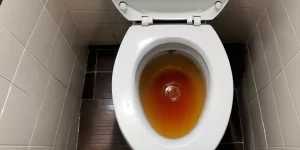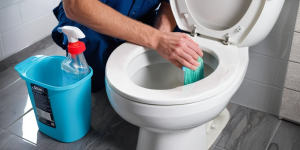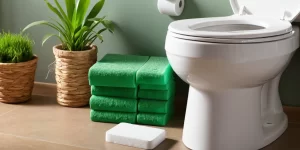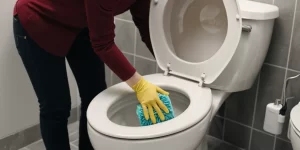In today’s world, maintaining a clean and germ-free bathroom is more essential than ever. The toilet seat, often overlooked, serves as a breeding ground for various harmful bacteria and viruses, making it crucial to prioritize its disinfection. Understanding which common germs lurk on toilet seats and selecting the right toilet seat disinfectant can significantly enhance your bathroom hygiene. In this comprehensive guide, we will explore the importance of disinfection, highlight key ingredients to look for in effective products, and review the top-rated disinfectants available. Additionally, we will compare different application methods and offer eco-friendly alternatives, ensuring you have all the information you need to create a safe and healthy environment in your home.
Understanding the Importance of Toilet Seat Disinfection
Maintaining a clean toilet seat is crucial not just for aesthetic reasons, but also for overall health. A toilet seat is often a hotspot for germs and bacteria, making regular disinfection essential for preventing illnesses. By understanding the importance of Toilet seat disinfectant, you can ensure a healthier environment for you and your family.
Key Reasons for Toilet Seat Disinfection
| Reason | Explanation |
|---|---|
| Preventing Infections | Actively kills harmful pathogens such as E. coli and salmonella, reducing the risk of infections. |
| Reducing Allergens | Disinfectants can eliminate dust mites and other allergens, improving air quality in the bathroom. |
| Maintaining Hygiene | A well-disinfected toilet seat provides peace of mind, especially for guests and family members. |
| Eliminating Odors | Germs contribute to unpleasant odors; disinfection helps keep smells at bay. |
In addition to mitigating the spread of germs, effective disinfection extends the lifespan of the toilet seat by preventing staining and wear over time. Regular use of a toilet seat disinfectant not only promotes cleanliness but also enhances the overall aesthetic of your bathroom space.
Furthermore, in a world inundated with various bacteria and viruses, safeguarding your home against these invisible threats is more critical than ever. Incorporating toilet seat disinfection into your weekly cleaning routine can significantly decrease your household’s risk of contamination. Embrace healthy habits today, and ensure a germ-free bathroom for everyone!
Common Germs Found on Toilet Seats
Toilet seats may appear clean, but they often harbor a variety of harmful germs that can pose significant health risks. Understanding the common microorganisms found in this high-traffic area is essential for effective disinfection and maintaining a healthy bathroom environment. Here are some of the most common germs encountered on toilet seats:
| Germ | Risk | Prevention |
|---|---|---|
| Escherichia coli (E. coli) | Can cause food poisoning and gastrointestinal issues | Regularly disinfect with a toilet seat disinfectant and maintain overall cleanliness. |
| Staphylococcus aureus | May lead to skin infections and respiratory issues | Wash hands thoroughly and train family members on proper hygiene. |
| Salmonella | Causes diarrhea and abdominal pain | Avoid contact with contaminated surfaces and ensure proper cleaning methods are utilized. |
| Norovirus | Highly contagious, leads to severe gastroenteritis | Use effective disinfectants that kill viruses, including toilet seat disinfectant products. |
| Candida albicans | Associated with yeast infections | Regular cleaning and avoidance of moisture accumulation in the bathroom can help prevent growth. |
These germs often spread through direct contact, making it crucial to implement proper hygiene practices. By regularly disinfecting toilet seats and surrounding areas, you can significantly reduce the risk of infection and ensure a healthier bathroom environment. Remember that prevention is key, so consider incorporating daily or weekly disinfection routines to stay ahead of harmful germs.
Key Ingredients to Look for in Disinfectants
When selecting a toilet seat disinfectant, it is essential to consider the active ingredients that make these products effective against germs. Knowing what to look for can help you choose a disinfectant that not only sanitizes but also ensures the safety of your family.
Common Active Ingredients
| Ingredient | Effectiveness | Safety |
|---|---|---|
| Sodium Hypochlorite | Kills bacteria, viruses, and fungi | Strong; use with caution |
| Quaternary Ammonium Compounds | Effective against a broad spectrum of germs | Generally safe if used as directed |
| Hydrogen Peroxide | Disinfects by oxidizing microorganisms | Safer alternative to bleach |
| Ethanol (Alcohol) | Works rapidly to kill bacteria and viruses | Highly effective; flammable |
Features to Consider
- Broad-Spectrum Efficacy: Choose products with ingredients that target a wide range of pathogens, including bacteria, viruses, and fungi.
- Fast-Acting: Look for disinfectants that ensure quick action, ideally within minutes, for more effective germ control.
- Safety for Household Surfaces: Ensure the disinfectant is safe for use on various surfaces, especially if you’re using it on sensitive materials.
Additional Properties
- Deodorizing Ability: Many disinfectants also include fragrances or deodorizing agents that help eliminate odors while disinfecting.
- Residue: Some formulations leave minimal residue, making them ideal for high-touch areas like toilet seats.
Selecting a disinfectant with the right ingredients will further enhance your cleaning routine, ensuring a germ-free bathroom environment.
Top Rated Toilet Seat Disinfectant Products
When it comes to ensuring a germ-free bathroom, selecting the right cleaning products is essential. Here’s a curated list of some of the top-rated options available that can help keep your toilet seats, and ultimately your entire bathroom, clean and hygienic. Each product is noted for its effectiveness, ease of use, and features.
| Product Name | Type | Key Features | User Rating |
|---|---|---|---|
| Clorox Disinfecting Wipes | Wipes | Kills 99.9% of germs, anti-bacterial, convenient packaging | 4.7/5 |
| Lysol Bathroom Cleaner | Spray | Cleans tough stains, mold & mildew prevention, fresh scent | 4.6/5 |
| Seventh Generation Disinfecting Spray | Spray | Plant-based ingredients, free from synthetic fragrances, EPA registered | 4.5/5 |
| Microban 24 Hour Sanitizing Spray | Spray | Long-lasting protection, eliminates bacteria, and ideal for multi-surface use | 4.4/5 |
| Scrubbing Bubbles Disinfectant Spray | Spray | Foaming action, cuts through grime, and leaves a fresh scent | 4.3/5 |
These products are highly rated for their efficacy in eliminating bacteria and viruses, while also considering ease of use. The wipes are incredibly convenient for quick clean-ups, while sprays typically offer a more thorough application allowing for better surface coverage. When choosing a product, consider your specific needs, such as sensitivity to fragrances or preference for eco-friendly ingredients. Always read labels and follow the manufacturer’s instructions for optimal results.
How to Properly Use Toilet Seat Disinfectants
Maintaining a germ-free bathroom is crucial for your overall health, and using a toilet seat disinfectant effectively is key to achieving this. Here is a step-by-step guide to ensure your toilet seat is sanitized properly:
- Choose the Right Product
Select a toilet seat disinfectant that fits your needs (spray or wipe). Ensure it contains effective germ-fighting ingredients. - Read the Instructions
Always read the label before use. Product instructions will provide essential information regarding application and contact time for optimal disinfection. - Pre-Clean the Surface
Before applying any solution, wipe the toilet seat with a dry cloth to remove visible dirt and grime. This step makes the disinfectant more effective. - Application Method
- Spray Disinfectant: Hold the nozzle 6-8 inches away from the seat and spray evenly, covering all surfaces.
- Wipe Disinfectant: Take a disinfectant wipe and thoroughly wipe the toilet seat, ensuring all areas are covered.
- Allow for Contact Time
Let the disinfectant sit for the recommended duration (typically 5-10 minutes). This waiting period allows the ingredients to kill germs effectively. - Wipe Away Residue
After the appropriate contact time, use a clean paper towel or cloth to wipe away any remaining disinfectant, ensuring no residue is left behind. - Dispose of Materials Properly
Dispose of any used wipes or paper towels in the trash bin. Do not flush disinfectant wipes, as they can cause plumbing issues.
| Step | Action |
|---|---|
| 1. Choose Product | Select appropriate spray or wipe |
| 2. Read Label | Follow usage instructions provided |
| 3. Pre-Clean | Wipe away visible dirt before disinfecting |
| 4. Apply | Use spray or wipe to cover all surfaces |
| 5. Contact Time | Let it sit for 5-10 minutes |
| 6. Wipe Residue | Remove any excess with a clean cloth |
| 7. Dispose | Throw away used wipes in the trash |
By following these steps, you can ensure a clean and germ-free toilet seat, contributing to a healthier bathroom environment.
Comparing Spray vs. Wipe Disinfectants
When it comes to maintaining a germ-free toilet seat, your choice between spray and wipe disinfectants can make a significant difference. Both options offer unique advantages and disadvantages that are worth considering.
Effectiveness
| Feature | Spray Disinfectants | Wipe Disinfectants |
|---|---|---|
| Coverage | Often covers large areas more easily | Focused application on specific spots |
| Penetration | Can reach cracks and crevices | Generally relies on direct contact |
| Drying Time | Usually dries quicker | Might require additional drying time |
Spray disinfectants typically provide a broad coverage area and can penetrate hard-to-reach spots effectively. On the other hand, wipes are designed for spot cleaning and offer a higher level of control when applying the solution to targeted areas.
Convenience
| Feature | Spray Disinfectants | Wipe Disinfectants |
|---|---|---|
| Storage | Often comes in larger bottles | Usually sold in compact, easy-to-store packs |
| Portability | Less convenient for travel | Ideal for on-the-go cleaning |
| Readiness to Use | Requires a separate cloth or paper towel | Ready to use out of the package |
Wipe disinfectants are convenient because they are pre-soaked and ready to use immediately. Conversely, spray disinfectants may necessitate additional tools for application.
Environmental Impact
| Feature | Spray Disinfectants | Wipe Disinfectants |
|---|---|---|
| Container Waste | Potentially larger bottles contribute | Often more packaging waste |
| Biodegradable Options | Available but limited | Many brands feature eco-friendly versions |
Choosing eco-friendly products, whether spray or wipe, enhances sustainability. However, wipe disinfectants tend to generate more waste.
In summary, both spray and wipe disinfectants serve a crucial role in toilet seat hygiene, but your specific needs dictate the better choice. Determine which attributes such as effectiveness, convenience, and environmental impact are most important for your bathroom cleaning routine.
Eco-Friendly and Natural Disinfectant Options
In today’s environmentally conscious world, many homeowners are on the lookout for eco-friendly and natural disinfectant options. These alternatives not only help maintain a germ-free bathroom but also reduce chemical exposure and environmental impact. Here are some popular toilet seat disinfectant choices that are gentle on the planet yet tough on germs:
| Disinfectant | Active Ingredients | Effectiveness | Eco-Friendly Features |
|---|---|---|---|
| Vinegar Solution | Acetic acid | Kills bacteria and viruses | Biodegradable and non-toxic |
| Hydrogen Peroxide | H2O2 | Effective against a wide range of germs | Breaks down into water and oxygen |
| Baking Soda | Sodium bicarbonate | Natural scrubber, deodorizer | Safe for the environment and skin |
| Essential Oil Blends | Tea tree, eucalyptus, lavender oils | Antimicrobial properties | Derived from plants, supports holistic cleaning |
| Castile Soap | Plant-based soap | Cleansing and antibacterial | Biodegradable and cruelty-free |
To create your own effective eco-friendly toilet seat disinfectant, consider combining equal parts vinegar and water in a spray bottle, and adding a few drops of essential oils for added fragrance and disinfectant properties. Regular maintenance with these natural solutions can ensure a clean and healthy bathroom without harsh chemicals.
Moreover, using these options not only contributes to better hygiene but also promotes sustainability, making it a win-win for your household and the environment.
Tips for Maintaining a Germ-Free Bathroom
Keeping your bathroom germ-free is essential for a healthy home environment. Adopting simple yet effective cleaning routines can significantly reduce bacteria, viruses, and other harmful pathogens. Here are several practical tips to maintain a sanitary bathroom:
| Tip | Description |
|---|---|
| Regular Cleaning | Clean your toilet, sink, and shower at least once a week. Use a powerful toilet seat disinfectant to ensure all areas are thoroughly sanitized. |
| Immediate Spill Control | Wipe up spills immediately to prevent the growth of bacteria. Make it a habit to disinfect surfaces as soon as they get dirty. |
| Ventilation | Ensure proper airflow in your bathroom by using exhaust fans or opening windows. This helps to reduce moisture and prevent mold growth. |
| Wash Towels & Mats | Launder towels and bath mats regularly. Bacteria thrive in damp environments, so always dry them properly after use. |
| Use High-Quality Products | Select disinfectants that are effective against a broad spectrum of germs. Look for those with key ingredients like bleach or alcohol. |
| Maintain Daily Practices | Encourage family members to wash their hands after using the bathroom and keep personal items off countertops. |
| Avoid Clutter | Reduce surfaces where germs can accumulate by keeping countertops clear of unnecessary items. Less clutter also makes cleaning easier. |
Implementing these tips not only ensures your bathroom remains clean but also fosters an overall healthier atmosphere. By creating a routine and using the right products, you can minimize the risk of germ spread effectively.
DIY Toilet Seat Disinfectant Solutions
Creating your own toilet seat disinfectant can be a cost-effective and eco-friendly way to maintain a clean and germ-free bathroom. Below are some simple recipes and tips to help you craft your own disinfecting solutions.
Simple Vinegar and Baking Soda Spray
This straightforward combination is excellent for disinfecting without harsh chemicals:
- Ingredients:
- 1 cup white vinegar
- 1 cup water
- 1 tablespoon baking soda
- Instructions:
- Combine vinegar and water in a spray bottle.
- Add baking soda carefully, as it will fizz.
- Shake gently to mix.
- Spray the solution on the toilet seat, let sit for 10 minutes, and wipe clean with a cloth.
Essential Oil Disinfectant
Enhance your disinfectant with pleasant scents and additional antibacterial properties:
- Ingredients:
- 1 cup rubbing alcohol (at least 70% concentration)
- 10 drops tea tree oil (known for its antimicrobial properties)
- 10 drops lavender or eucalyptus oil
- Instructions:
- Mix the rubbing alcohol and essential oils in a spray bottle.
- Spray the mixture directly onto the seat and allow it to air dry for thorough sanitation.
Benefits of DIY Solutions
| Feature | Store-Bought Products | DIY Solutions |
|---|---|---|
| Cost | Higher | Low |
| Chemical Exposure | Often harsh chemicals | Natural ingredients |
| Customization | Limited | Fully customizable |
| Environmental Impact | Varies | Generally eco-friendly |
By opting for homemade disinfectants, you not only save money but also reduce your carbon footprint. Use these DIY solutions regularly for a cleaner and healthier bathroom.
Best Practices for Bathroom Hygiene
Maintaining a germ-free bathroom is essential for your health and well-being. Implementing effective practices not only promotes cleanliness but also prevents the spread of germs. Here are some best practices to incorporate into your daily bathroom hygiene routine:
| Practice | Description |
|---|---|
| Regular Cleaning | Clean all surfaces, including toilets, sinks, and countertops, at least once a week. Use a toilet seat disinfectant for optimal results. |
| Ventilation | Ensure proper airflow by keeping windows open or using an exhaust fan to reduce moisture and prevent mold buildup. |
| Hand Hygiene | Always wash your hands with soap and water after using the toilet. Consider using alcohol-based hand sanitizer as an additional measure. |
| Limit Personal Items | Avoid placing personal items like towels and cosmetics on bathroom surfaces where germs can accumulate. |
| Flush with the Lid Down | To prevent germ particles from dispersing into the air, always flush your toilet with the lid closed. |
| Use Disposable Items | Whenever possible, use disposable items like paper towels instead of cloth towels to decrease the chance of cross-contamination. |
| Germ-Free Accessories | Invest in bathroom accessories that are resistant to bacterial growth, such as antimicrobial toilet brushes and soap dishes. |
By adhering to these practices, you can significantly reduce the presence of harmful microorganisms and create a cleaner, safer bathroom environment. Remember, consistency is key to effectiveness in maintaining bathroom hygiene!
Frequently Asked Questions
What are the key benefits of using a toilet seat disinfectant?
Using a toilet seat disinfectant primarily enhances sanitation by eliminating harmful germs and bacteria that thrive in and around the toilet. Regular application helps prevent illnesses, particularly those spread via contact. Additionally, disinfectants can assist in minimizing unpleasant odors and keeping the toilet area fresh. Some products also form a protective barrier that repels dirt and stains, making cleaning easier and less frequent while providing peace of mind regarding hygiene.
Are there any specific ingredients I should look for in a toilet seat disinfectant?
When selecting a toilet seat disinfectant, it’s advisable to look for active ingredients known for their germicidal properties, such as benzalkonium chloride, sodium hypochlorite, or hydrogen peroxide. These ingredients effectively kill a broad range of pathogens. It’s also beneficial to choose products that are EPA-approved, which ensures they meet safety and effectiveness standards. Additionally, consider products that are free from harsh chemicals like ammonia or bleach to protect surfaces and the environment.
How often should I disinfect my toilet seat?
The frequency of disinfecting your toilet seat largely depends on household usage. Ideally, it is recommended to disinfect the toilet seat at least once a week to maintain optimal hygiene. However, high-traffic bathrooms or those used by multiple people may require more frequent disinfection, such as every few days. Always ensure that you disinfect after any cleaning activities or if someone in the household is ill to reduce the risk of germ transmission.
Can I use regular household cleaners instead of toilet seat disinfectants?
While regular household cleaners may remove visible dirt and grime, they often do not kill the specific bacteria and viruses that a toilet seat disinfectant is designed to target. Disinfectants contain active ingredients formulated specifically for germ removal, whereas standard cleaners may lack these properties. Therefore, for effective sanitation, it is crucial to use products specifically labeled as disinfectants to ensure a germ-free surface.
Are toilet seat disinfectants safe for all surfaces?
Toilet seat disinfectants are generally designed for porcelain or plastic toilet seats, but it is essential to read the product labels to ensure compatibility with your specific seat material. Some disinfectants may contain ingredients that can cause discoloration or damage to certain surfaces, especially wooden or painted seats. Always conduct a patch test in a small, inconspicuous area if you are uncertain about the product’s safety on your toilet seat material.





